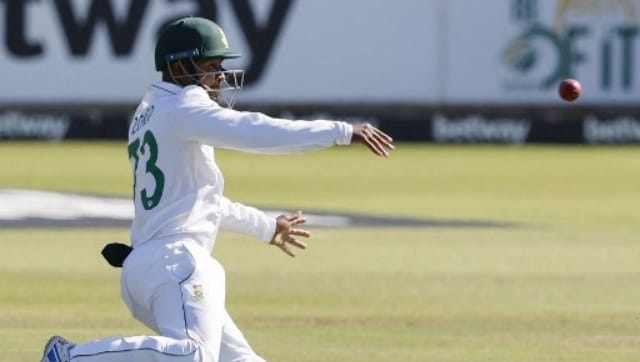Explained: How Khaya Zondo made his debut on Day 4 of second South Africa-Bangladesh Test – Firstcricket News, Firstpost
In a first in international cricket, two players from the South Africa team were withdrawn from the side that were facing Bangladesh in the second Test at Gqeberha and replaced with two ‘COVID-19 substitute players’, after the duo tested positive for COVID-19 on Monday morning.
Sarel Erwee and Wiaan Mulder were forced to withdraw from the Test due to positive COVID-19 tests ahead of Day four of the second Test, and they were replaced by Test debutant Khaya Zondo and Glenton Stuurman.

South Africa’s Khaya Zondo on Day four of the second Test. AFP
South Africa went onto win the second Test by 332 runs, as well as clinch the two-match series 2-0.
This was not the first time the series was affected by COVID-19. Bangladesh coach Russell Domingo tested positive for COVID-19 last week and was not able to attend this Test, as were South Africa’s bowling coach Charl Langeveldt and security officer Zinaid Wadee.
Here, we explain everything about COVID-19 substitutes in cricket, when and why they were introduced:
What are COVID-19 substitutions?
As the name suggests, COVID-19 substitutions happen when a player named in the XI starts showing COVID symptoms. This rule has been only applicable in Test cricket, and not in ODIs or T20s.
Why was this implemented and when was the decision of COVID-19 substitutes first taken?
It was on Monday morning that the official Twitter handle of Cricket South Africa (CSA) confirmed that Khaya Zondo would be making his Test debut on Day 4 of the second Test against Bangladesh.
“Khaya Zondo will make his Test debut on Day 4 of the 2nd #BetwayTest against Bangladesh after Sarel Erwee and Wiaan Mulder tested positive for Covid-19. The pair will be replaced with Zondo and Glenton Stuurman,” CSA had tweeted.
It thus became the first recorded instance of COVID-19 substitutions in international cricket since the rule was introduced, and also the first time players were being replaced midway through the contest after testing positive for the virus.
Back in June 2020, the ICC’s Chief Executive Committee (CEC) had approved the usage of COVID-19 substitutes, albeit only in Test cricket.
A statement from ICC had mentioned that in line with the concussion replacements, the official Match Referee would approve only like-for-like replacements as far as COVID-19 substitutes were concerned.
“Teams will be allowed to replace players displaying symptoms of COVID-19 during a Test match. In line with concussion replacements, the Match Referee will approve the nearest like-for-like replacement.
“However, the regulation for COVID-19 replacements will not be applicable in ODIs and T20Is,” the ICC had stated in a media release back then.
At the time of making the decision, COVID-19 substitutes were among the interim changes brought in by the ICC, along with banning use of saliva (which was made permanent this year) and non-neutral umpires.
Have there been instances of COVID-19 substitutes in cricket before?
Yes, there have been. On 20 October, 2020, Auckland pacer Ben Lister became the first COVID-19 substitute player, replacing teammate Mark Chapman during a Plunket Shield encounter against Otago.
Chapman had fallen ill and was awaiting results of his COVID-19 test when Lister was named the substitute.
In the first innings of Otago’s batting, Lister had finished with figures of 1/40.
In May 2021, Somerset’s Jack Brooks became the first COVID-19 substitute in English county cricket, when he replaced pacer Lewis Gregory.
Gregory’s girlfriend had fallen ill at the time and although she had returned negative in a lateral flow test, Gregory was forced to isolate until she returned RT-PCR negative.
Who said what?
The South Africa-Bangladesh series was being played inside a managed environment, instead of a bio-bubble, but this wasn’t unexpected, said Cricket South Africa’s (CSA) chief medical officer.
“This is an unfortunate situation, but not unexpected after the decision was made to have this tour under the Managed Event Environment (MEE) protocol, rather than the strict Bio-safe Environment (BSE) Protocol as was previously the case,” said Dr Shuaib Manjra, the medical officer said, according to ESPNCricinfo.
“This is in line with the country’s policy in revoking the Disaster Management Act with reference to the pandemic, as well the huge mental strain that a bubble environment induces,” Dr Manjra added.
Read all the Latest News, Trending News, Cricket News, IPl Live Score UpdateLatest IPL Schedule 2022, and , IPl 2022 Points tableEntertainment News here. Follow us on Facebook, Twitter and Instagram.
For all the latest Sports News Click Here

